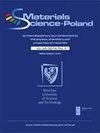生物合成碳点作为生物成像荧光探针的应用进展
IF 1.3
4区 材料科学
Q4 MATERIALS SCIENCE, MULTIDISCIPLINARY
引用次数: 0
摘要
碳点(CD)具有发射可调、生物相容性好、表面功能化简单、易于合成等优点,正在成为生物成像应用的多功能荧光纳米探针。本综述总结了将生物合成 CD 应用于灵敏生物成像的最新进展。通过水热法和微波合成等绿色技术从可持续生物质资源中提取的光盘显示出明亮、激发可调的光致发光,光谱范围从可见光到近红外。通过对合成参数和表面钝化策略的精心控制,量子产率提高了 50%以上,可与有毒半导体点媲美。与聚合物、肽和识别元素(如抗体)的共轭可提高对癌细胞和生物标记物的溶解性和选择性。标准品系的体外验证显示了靶向细胞器成像能力。体内给药显示了肾清除药代动力学,通过增强的渗透效应优先在肿瘤中积累。在成像引导下,通过化疗和光热消融的综合治疗效果,使用 CDs 药物制剂在小鼠异种移植中实现了平均约 50-80% 的肿瘤生长抑制率。不过,在进一步临床转化之前,还需要解决长期暴露的毒性、大规模可重复生产以及多模态成像能力等问题。本文章由计算机程序翻译,如有差异,请以英文原文为准。
Advances in the application of biosynthesized carbon dots as fluorescent probes for bioimaging
Carbon dots (CDs) are emerging as versatile fluorescent nanoprobes for bioimaging applications due to advantages like tunable emissions, excellent biocompatibility, facile surface functionalization, and ease of synthesis. This review summarizes recent advances in applying biosynthesized CDs for sensitive bioimaging. CDs derived from sustainable biomass sources through green techniques like hydrothermal and microwave synthesis demonstrate bright, excitation-tunable photoluminescence spanning visible to near-infrared spectra. Careful control of synthesis parameters and surface passivation strategies enhance quantum yields above 50% comparable to toxic semiconductor dots. Conjugation with polymers, peptides, and recognition elements like antibodies impart solubility and selectivity towards cancer cells and biomarkers. In vitro validation in standard lines shows targeted organelle imaging abilities. In vivo administration reveals renal clearance pharmacokinetics with preferential tumor accumulation via enhanced permeability effects. Average tumor growth inhibition around 50-80% was achieved in mouse xenografts using CDs-drug formulations through combined therapeutic effects of chemotherapy and photothermal ablation under imaging guidance. However, concerns regarding toxicity from chronic exposures, large-scale reproducible manufacturing, and multimodal imaging capabilities need redressal prior to further clinical translation.
求助全文
通过发布文献求助,成功后即可免费获取论文全文。
去求助
来源期刊

Materials Science-Poland
MATERIALS SCIENCE, MULTIDISCIPLINARY-
自引率
18.20%
发文量
18
期刊介绍:
Material Sciences-Poland is an interdisciplinary journal devoted to experimental research into results on the relationships between structure, processing, properties, technology, and uses of materials. Original research articles and review can be only submitted.
 求助内容:
求助内容: 应助结果提醒方式:
应助结果提醒方式:


